Poetry Analysis Teaching Resources
Explore poetry analysis in your primary school classroom with printable poems, worksheets, graphic organisers and more teaching resources created by primary teachers for primary teachers like you!
Aligned with the Australian curriculum standards, each resource in this collection was created to help students build their skills in learning how to analyse a poem. Each one has undergone a thorough review by a member of our teacher team to ensure it's ready for your lesson plans and your students.
Looking for some tips on teaching kids to explore and interpret various poems? Read on for a primer from our teacher team, including definitions of key vocabulary and some poems perfect for primary school students to analyse.
What Is a Poem? A Kid-Friendly Definition
If your students are just learning about poetry, it can be helpful to start off with a definition that explains what a poem is. Here's one from our teacher team!
A poem is a type of writing that uses words to create pictures and tell stories in a fun and interesting way. Poems are like songs without music because the words have a special rhythm and sometimes even rhyme with each other. Poems have a special structure that makes them different from stories, articles and other types of writing that you learn about.
What Is Poetry Analysis? A Kid-Friendly Definition
Let's start off with a kid-friendly way to explain what it means to analyse a poem that you can share with your students!
Poetry analysis is a process we use to better understand what a poet is trying to convey to the reader of a poem.
It involves process of reading the poem closely, paying attention to its words, sounds and imagery, and thinking critically about how all these elements work together to create a deeper message or evoke certain emotions in the reader.

Teachers' Favourite Poems for Teaching Kids How to Analyse a Poem
Are you looking for some perfect poems for teaching your students to analyse poems? Here are a few of the best poems for teaching everything from studying poem structure to figurative language to theme!
- Hope Is the Thing With Feathers by Emily Dickinson — Dickinson personifies hope in this classic poem, giving it the qualities of a bird with feathers. Your students can analyse how the personification creates a vivid and relatable image. They can also explore the use of metaphor and symbolism, as Dickinson compares hope to a bird that sings in the face of adversity
- The Road Not Taken by Robert Frost — This classic poem is a teacher-favourite for teaching poetry analysis that allows students to consider choices and consequences. The Frost classic features the use of metaphor, as the road represents life's choices. You can also use this poem to examine the rhyme scheme (ABAAB) and the rhythm (iambic tetrameter).
- Where I Am From by George Ella Lyon — This poem from the co-creator of the I Am Project is full of sensory language as it details the poet's various life experiences.
- Annabel Lee by Edgar Allan Poe — This popular poem by celebrated poet Poe explores themes of love and loss and makes use of both alliteration — as seen in lines like "But we loved with a love that was more than love" — and repetition.
- Trees by Joyce Kilmer — Kilmer's popular poem is a simple and accessible poetry example that's prime for younger students. Kilmer attributes human qualities to trees, showcasing personification, while it also offers students a chance to consider the theme of nature. Looking at rhyme scheme and rhythm? Trees uses the AABBA rhyme scheme, which contributes to the poem's sing-song quality.
- The Song of Hiawatha by Henry Wadsworth Longfellow — This epic poem is book-length, so you'll want to stick to single sections for analysis, but it's packed with repetition ("By the shores of Gitche Gumee."), alliteration and imagery, and students can identify the poem's trochaic tetrameter rhythm.
- The Spider and the Fly by Mary Howitt — "Step into my parlor," begins this classic poem about a spider luring a fly into its web. Challenge your students to identify the AABB pattern and the use of personification.
- Plus Plan

Poetic Devices Teaching Slides
Explore examples of poetic devices using this comprehensive and age-appropriate slide deck perfect for your poetry writing unit.
- Plus Plan
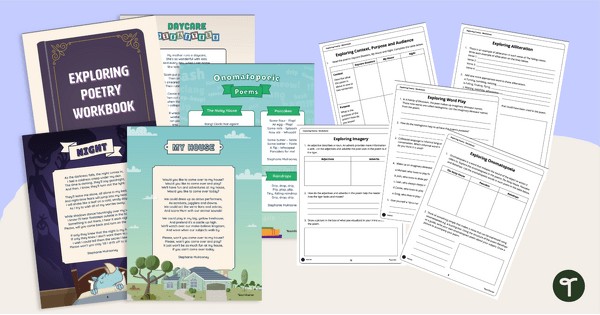
Exploring Poetry Workbook
Teach your students about all things poetry with this jam-packed poetry workbook created especially for primary school students.
- Plus Plan
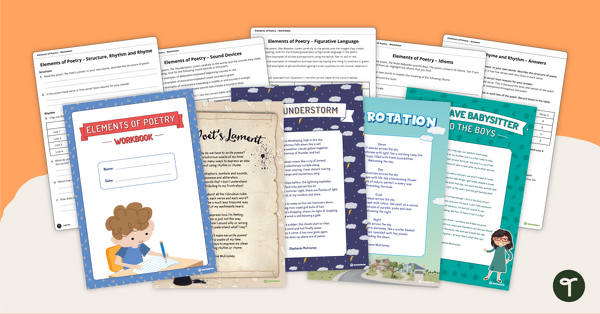
Elements of Poetry Workbook
Explore the wonders of poetry with this set of poems and accompanying worksheets designed specifically for children.
- Plus Plan

Back to School Today — Short Poem for Kids
Use this short poem for kids when students return to school. This child-friendly poem discusses feelings that they may experience when heading back to school after an extended break.
- Free Plan

Poetry Vocabulary Words – Word Wall
Display and discuss vocabulary related to poetry and figurative language with a set of 30 word wall cards.
- Plus Plan

Elements of Poetry Teaching Slides
Explore the key elements of poetry with your students using this comprehensive and age-appropriate slide deck perfect for your poetry writing unit.
- Plus Plan

Poetry Analysis Template
A 1 page template for students to use when analysing a poem.
- Free Plan

Poetry Analysis Worksheet Pack
Analyse and comprehend a variety of poetry types with a printable Poetry analysis worksheet pack.
- Plus Plan

A Thinker Like Me - Read and Respond Worksheet
A comprehension activity related to a poem.
- Plus Plan

Little Tree (Poem) – Worksheet
A comprehension worksheet for a poem from the Foundation magazine (Issue 1).
- Free Plan

I Am Sorry – Poem and Discussion Questions
A poem to promote thoughtful discussion around issues of reconciliation on National Sorry Day.
- Plus Plan

A Colourful World (Poem) – Worksheet
A comprehension worksheet for a poem from the Foundation magazine (Issue 2).
- Plus Plan

The Waterfall – Worksheet
A comprehension worksheet for a poem from the Year 2 magazine (Issue 2).
- Plus Plan
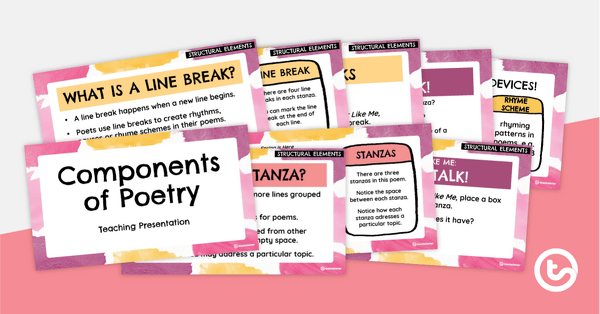
Components of Poetry PowerPoint
An editable PowerPoint to use when teaching the essential components of poetry.
- Plus Plan

Spring Is Here Poem – Worksheet
A comprehension worksheet for a poem about the season spring.
- Plus Plan

Analysing Poetry Teaching Slides
Teach your students how to analyse poetry using the SMILE technique with this comprehensive and age-appropriate slide deck.
- Plus Plan

The Poet's Lament - Comprehension
A comprehension activity using a poem.
- Plus Plan

Poetry Resource Folder Cover and Dividers
Use this collection of templates to organise your classroom poetry resources folder.
- Plus Plan
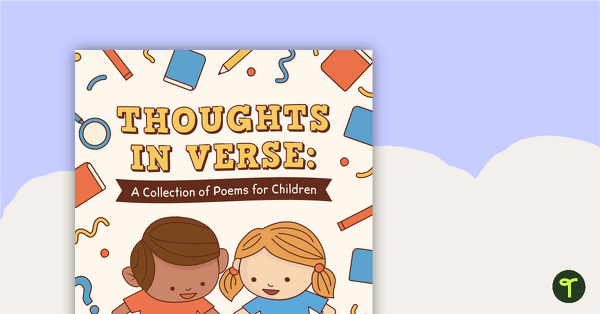
Thoughts in Verse: A Collection of Poems for Children
A beautifully designed collection of poems, written especially for children.
- Plus Plan

'I take it you already know' - Poster
A poster displaying 'I take it you already know', a poem describing the difficulties in the English language.
- Plus Plan

The Park - Comprehension
A comprehension activity using poetry.
- Plus Plan

Exploring Poetry Worksheet - Alliteration
A worksheet to help students understand alliteration in poetry.
- Plus Plan

In My Eyes (Poem) - Comprehension
A comprehension activity using poetry.
- Plus Plan

Storytelling Through Poetry
A 60 minute lesson in which students will explore storytelling through poetry.
- Plus Plan

Imagery in Poetry
A 60 minute lesson in which students will identify and explore imagery in poetry.
- Plus Plan

Word Play in Poetry
A 60 minute lesson in which students will identify and explore word play in poetry.
- Plus Plan

Purpose, Audience and Context
A 60 minute lesson in which students will identify the purpose, intended audience and subject matter of a poem.
- Plus Plan

Poetry Defined
A 60 minute lesson in which students will develop an understanding of what constitutes poetry.
- Plus Plan
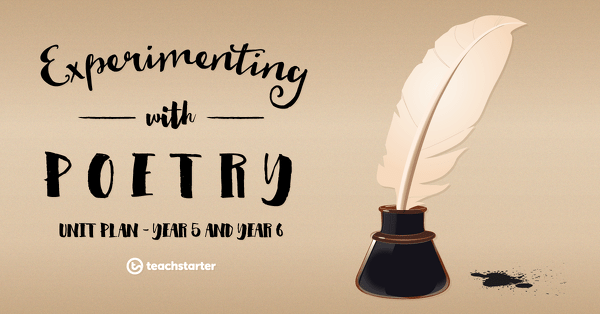
Structure, Rhyme and Rhythm
A 60 minute lesson in which students will identify and investigate structure, rhyme and rhythm in poetry.
- Plus Plan

Elements of Poetry
A 60 minute lesson in which students will explore the common elements found in poetry.
- Plus Plan
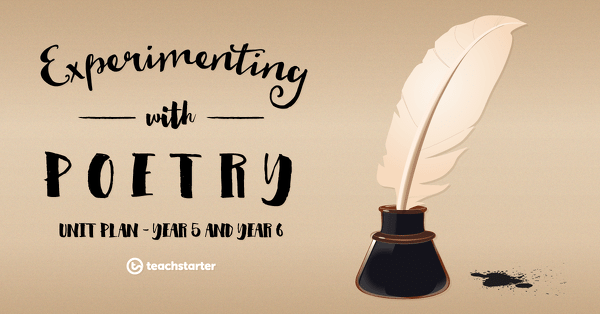
The Poet's Lament
A 60 minute lesson in which students will explore their preconceived ideas and attitudes towards poetry.
- Plus Plan

Experimenting with Poetry Unit Plan - Year 5 and Year 6
This English unit addresses the common elements of poetry and explores how these may be applied to shape poems, limericks, odes and simple ballads.